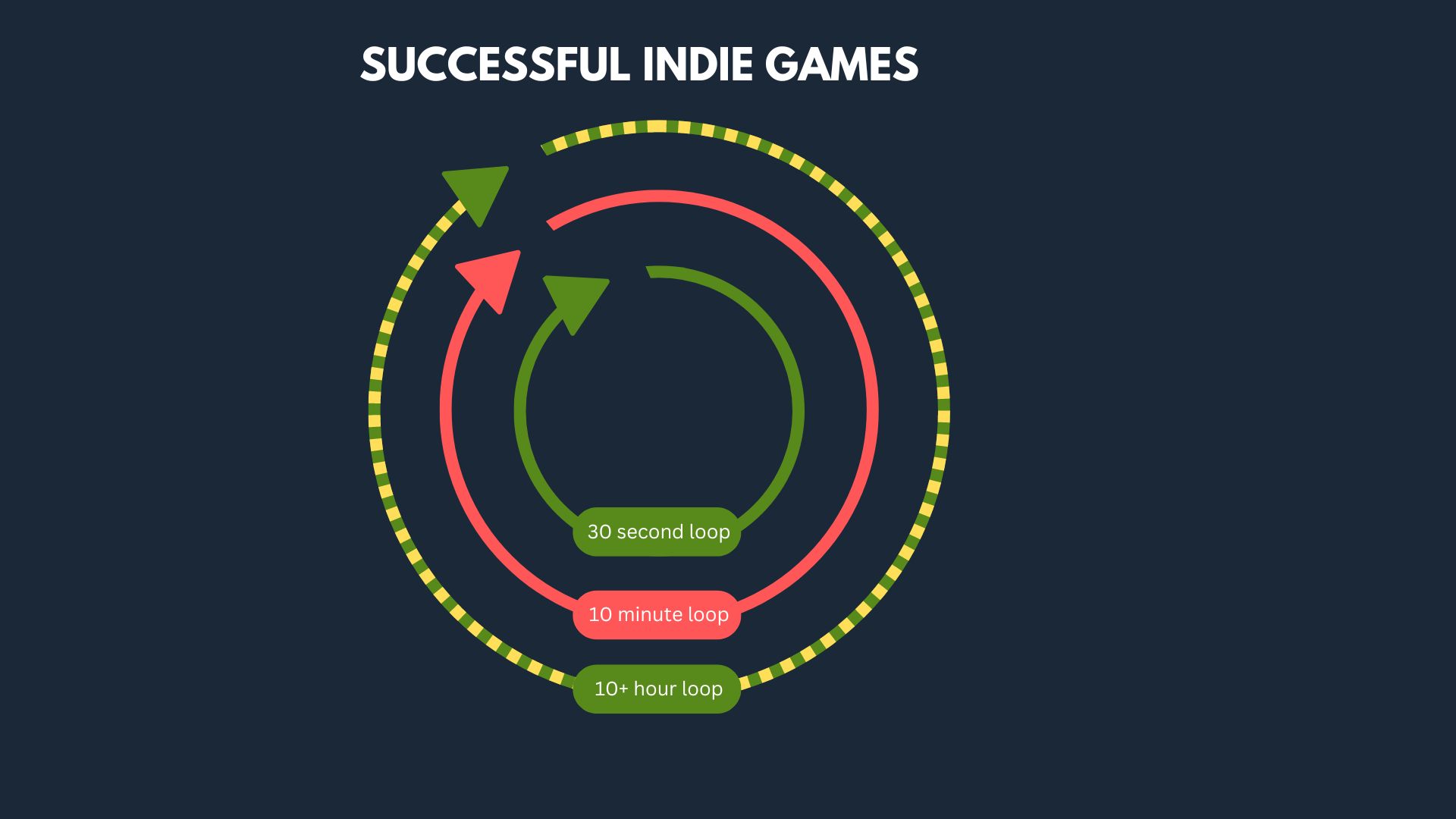
I always say that the Steam player base is “hard core.” They love deep games with lots of content. They like UIs that are complex and cluttered. If you asked me for a screenshot that perfectly encapsulates the types of games that the Steam player base loves, it would be this one from Hearts of Iron IV.

Similarly I have written previous blog posts warning developers that it is very risky to make a game that is “Casual” or trying to attract the “non gamer” because you will be spending most of your marketing budget trying to convince a very skeptical audience to change their behavior. Instead you should leave that huge task to well capitalized companies like Nintendo.
Steam players like complexity, but do they like difficulty?
Ironically they don’t like difficulty, mostly.
I would say they like games that are Easy-Hard-Easy.
In today’s blog post I am totally going off “my gut.” I don’t have data for this. I just have played a bunch of best selling indie games and not so best selling indie games and have seen patterns.
I am also dipping my toe a bit in game design. I am not a great game designer so again take this all with a grain of salt.
This blog is just my opinion after seeing a bunch of games miss the mark.
Easy-Hard-Easy games
So my mental model of successful Indie-scale games is that they should be Easy-Hard-Easy (but variable).
I represent it by this diagram:

Every game is built upon short term game loops, medium term game loops, long term game loops. There are things you do every 10 seconds, and you repeat those 10 seconds of play and then jump out and do something else every 10-ish minutes. Then chain together the outcomes of those 10 minute play sessions to contribute to the outer gameplay loop which has goals that take hours to accomplish.
So I argue, that the ideal Steam game has a very very easy 10 second loop that doesn’t use too many buttons. It is almost deceptively simple.
But then the 10 minute loop is VERY hard. They are almost laughably hard. This difficulty spike is why many people think Steam games are for a Hardcore audience.
However, the outer gameplay loop serves to soften the blow of the brutal middle loop.
Why is the outer loop green and yellow mixed in my diagram? Because, for the successful Steam genres, the outer loop is typically an open world, non-linear, non-directed upgrade system that allows players to customize their play experience to fit their difficulty preferences.
It is Green dashed with Yellow because if a player wants more challenge they can spend less time upgrading their character or if they are having a hard time (Yellow Difficulty), or they grind for more resources and it becomes easier (Green Difficulty). The outer level adapts to each individual-player’s behavior.
How Successful Indie Games On Steam Use this
Crafty Buildy Simulation games are my shorthand description for a panoply of genres where you are basically given a sandbox and you as the player craft or build things to accomplish goals. Often you aren’t even controlling a player, instead you are controlling a cursor and selecting things on a map. Think of strategy games, city builders, open-world-survival-craft, auto-battlers, idle games, colony sims, space-ship builders, tycoon-management games, roguelike-deck builders, management sims, and simulators (yes I know simulators are typically first person, but you are basically a physical cursor just walking through an environment clicking on things).
Crafty-buildy-sims are the games Steam players love.
So as I said, the perfect Steam game is easy-hard-easy. Crafty-buildy-games are a perfect fit for this game loop structure. The game design of these open world, crafty-buildy games allows players to ease into the game with easy short term gameplay, but are quickly challenged with a very hard middle game loop, but they can overcome the challenge with a non-linear, non-mandatory overall loop that ensures that they are never stuck forever. It is just a matter of them investing the amount of time to fit their skill level.
This gameplay loop also ensures “endless” replay-ability.
Let me use Minecraft as an example because it is the most successful indie game ever made:
Minecraft
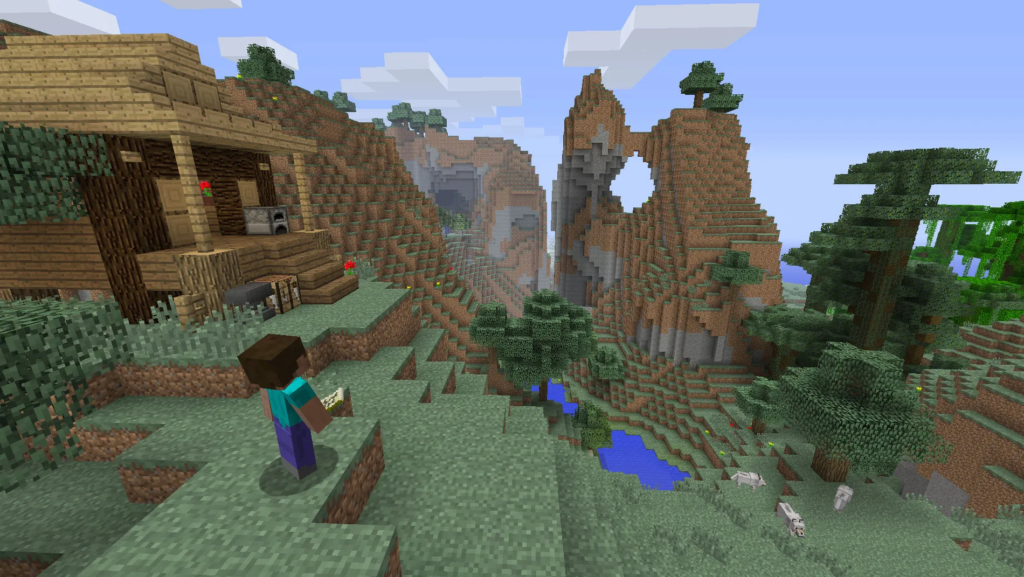
Core loop (15 seconds) (Easy Difficulty)
Punch a tree and loot comes out. Dig through a bunch of stone then ore and gems come out. Super satisfying. The controls are very simple. You just hold down the punch button, then walk over whatever drops.
Middle loop (10 ish minutes) (VERY HARD Difficulty)
The middle loop in Minecraft is about 13 ish minutes. It is safe to explore and scout for resources and punch trees or find and raid villages for loot. But after 10 minutes and 30 seconds day turns to night and you have to run back to your home base to sleep, eat, and restock. The night in minecraft is full of zombies and skeletons and is REALLY HARD. Then you sleep, wake up in the morning and repeat the core loop the next day.
Another similar loop is you go down into a cave, dodge skeletons, find a bunch of diamond and gold, fill up your inventory or break all your pick axes and then get back up to the surface. You are pushing your luck if you are still spelunking after 10 minutes. This game is so hard. Every time I die I shout HOW IS THIS GAME FOR CHILDREN! Then my son makes fun of me.
The middle loop is also where the crafting lives. You really need to learn and understand what items to craft and how to use them to get to new places. You basically need an 8 year old to hold your hand through this part.
Outer Loop (30+ hours) (Variable difficulty from EASY to VERY HARD)
Minecraft can basically be played forever but the culminating path is getting to and defeating the “Ender Dragon” which requires hours of collecting resources so you can get access to advanced biomes and equipment. It is challenging to get to the final area but the interesting thing is that you get to set the skill level based on how you play.
For instance “The Nether” is a biome later in the game and it is very hard because everything is on fire, and everything wants to kill you and there is no day/night cycle. It is basically difficult at all times. BUT, you can grind to get more armor to give you more hit points, more potions, better weapons to improve your chances in the Nether. Basically you can make it easier by grinding for more resources. Or if you are very skilled you can go into the encounters faster but more lightly equipped.
This is the genius of endlessly replayable games. The player gets to set the difficulty without specifically sliding a “difficulty” widget in the settings menu. They set the difficulty by how they play. If the game is too hard, just keep grinding for stuff to level up your character until they are strong enough to beat the game.
Also, there is no hard gating like in say a puzzle game. There is no point where it is like, you must solve my riddle and solve this puzzle and then you can pass. Open world games are very… well…. open ended. There are no levels. There is no one way to beat an enemy. There is no one boss that has a specific pattern you have to learn using a specific loadout. A lot of the time you can “cheese” an enemy and get an easy victory. Some players may not like to play it in a cheesy way, but it is up to them to set the difficulty.
Vampire Survivors

Vampire is emblematic of the “roguelike” design. There is a reason why every single indie game seems to be <genre x>-but-with-roguelike elements. Stapling a roguelike meta layer solves a lot of design problems.
Roguelike-mechanics is basically the outer two rings. Very difficult minute-to-minute gameplay with easy-if-you-grind outer loop.
Let me explain using VS as an example.
Core loop (15 seconds) (Easy Difficulty)
Walk around, automatically shoot enemies, walk over XP crystals. Notice how simple the controls are. There are no button presses. Just D-pad. When I interviewed the Deep Rock Galactic Survivor devs they debated adding a Dash button to the mix. But they decided that Survivor-like games are best when the controls are as simple as possible. Auto-shoot, no special moves. Keep it simple.
If this is all you did, this would be a dumb game.
Middle loop (10 ish minutes) (VERY HARD Difficulty)
The survivor likes are all about surviving as long as possible. The number of enemies increases. Most runs are 10-20 minutes depending on the mode. In fact one of the best games in the genre is called 20-minutes till dawn.
But it is almost laughable how hard VS can get at this loop. The number of enemies and the number of hits they absorb is really challenging.
Why is this game so popular? It is hard! I only survive 5 minutes. WHAT?!?
But then comes the outer loop…
Outer Loop (30+ hours) (Variable difficulty from EASY to VERY HARD)
After each round the player can use gold collected in the Middle loop on “permanent” upgrades.
By making purchases they are making the Middle loop easier. To fully upgrade the player it requires lots of grinding to collect enough gold. But if a player is really good they can survive longer without needing as many power ups.
Again, similar to Minecraft, if a player is low skilled or stuck, they just need to invest more time to eventually unlock, or collect the upgrades necessary, to get past the foe. There is no hard gate.
.
Why puzzle games / platformers are such a hard sell on Steam
I have written about how puzzle platformers and platformers are such a hard sell on Steam. But why?
There are a couple reasons but I think the biggest one is that players can get stuck either because of a challenging puzzle, or because of a very high skill gate. When players reach that skill gate, their only option is to just give up and move on.
We also find this difficulty cliff is why Content Creators don’t play puzzle games as much. If a live streamer gets stuck on a puzzle, the boisterous vibes of the stream come to a screeching halt as the host of the show just endlessly pounds their head against the wall hoping to figure out a solution. It doesn’t make for good viewing and the host doesn’t want to look like an idiot. Read this great post by YouTuber Wanderbots about this.
This isn’t a problem for “crafty-buildy” games though. Even if the content creator isn’t good at a game, they are never stuck. They just have to grind longer. And if their audience is having fun while they grind for loot, great! There is just more content automatically generated.
Puzzle Games
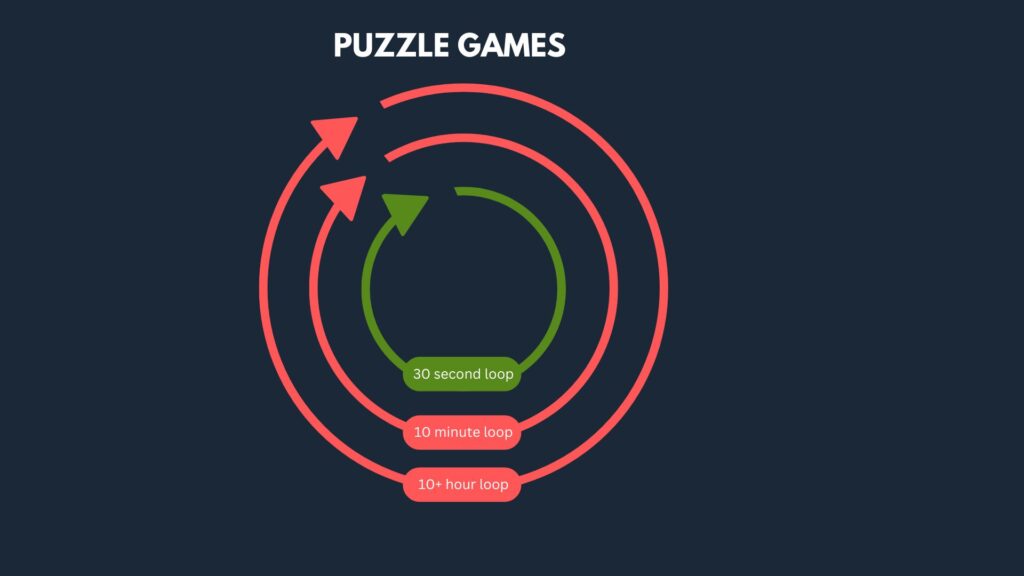
Puzzle games have a Easy-Hard-Hard gameplay loop which is the reason they are so risky.
Core loop (15 seconds) (Easy Difficulty)
The core loop of a puzzle game is usually pretty simple. Push a block around. Shoot a portal gun. Jump on a pressure plate and watch a gate rise. Fun!
Middle loop (10 ish minutes) (Increasing Difficulty)
Early puzzles are easy, but as the designer makes them harder, players may spend more time knitting together the core loop concepts.
If a designer didn’t playtest an individual puzzle well enough, the player may end up confused, frustrated and unable to proceed.
A frustrated player at this stage might blindly start spamming moves, hoping they might complete the puzzle by brute force of trying every possible move.
Outer Loop (5+ hours) (Designer set difficulty HARD)
This is where puzzle games really find trouble on Steam. A good designer will gradually increase the difficulty of the puzzles. A genius designer will create later-stage puzzles that rely on multiple lessons that they learned from previous puzzles. But if a player gets stuck on one of the earlier puzzles and never fully understands it, then they have no hope of beating the later puzzles.
Puzzle games do not allow you to “grind” for XP to make the puzzles easier. This is often a feature not a bug for puzzle designers. Puzzle designers love to boast that players do not have to artificially grind for XP or to unlock abilities to proceed, instead puzzle game players proceed because they become smarter. That sounds so pure and like it should be a good thing, but it also stops players from proceeding who just don’t “get” what the designer is trying to teach them.
Puzzle games also tend to be shorter because it is really expensive to generate new puzzles.
Now some puzzle games have introduced “hint” systems where if you beat enough puzzles you can pay to unlock a hint. But this seems artificial and I bet (again, no data) that players don’t like buying their way out of solving a puzzle. It isn’t satisfying.
Platformers / Metroidvanias

Core loop (15 seconds) (Medium / Hard Difficulty)
Jump across a chasm. Jump, shoot an enemy, switch weapons, shoot another one, block.
I grew up playing platformers so I have internalized the rapid hand movements required to navigate a level. But not all gamers grew up playing Super Mario, Super Metroid, or Ninja Gaiden. We designers underestimate how much dexterity is required to successfully navigate a platformer. They are HARD and failure is often very brutal.
When I was making my platformer game I did a playtest at a local meetup for content creators. A couple of the creators actually put down the controls and said “I just can’t play platformers.” A whole generation of players just don’t have experience with 2D platformers. These players are stuck at the very first loop.
Middle loop (10 ish minutes) (Hard Difficulty)
Levels are often 5-10 minutes (depending on the game). Depending on the checkpointing system you might have to restart all the way to the beginning. Think of Super Meat Boy where you have to gradually learn the timing and strength of each jump between saw blades in sequence until you get to the last blade.
Outer Loop (5+ hours) (Designer set difficulty HARD)
Similar to puzzle games, a platformer builds in difficulty based on the designer’s intentions. But most designers like to stack later levels so completing them requires you to combine skills you learned in previous levels. If you just can’t master a wall jump, you are kind of out of luck when in a later level you must wall jump and shoot.
Metroidvanias sort of get around this wall by giving the character upgrades that you can “farm” by exploring more. The more missiles and energy tanks you collect, the easier the final boss encounter will be.
But overall, Platformers typically have the same problem that puzzle games do: there is some point where the player skill (or lack thereof) runs up against the design and there is no way around it.
Nintendo has tried to get around this with “accessibility” features where players can jump into a bubble and float past trouble points, or collect “badges” that give you special abilities to make the game easier, but this doesn’t seem to be as universal or as natural to the design as it is for open world survival craft.
First time developer games
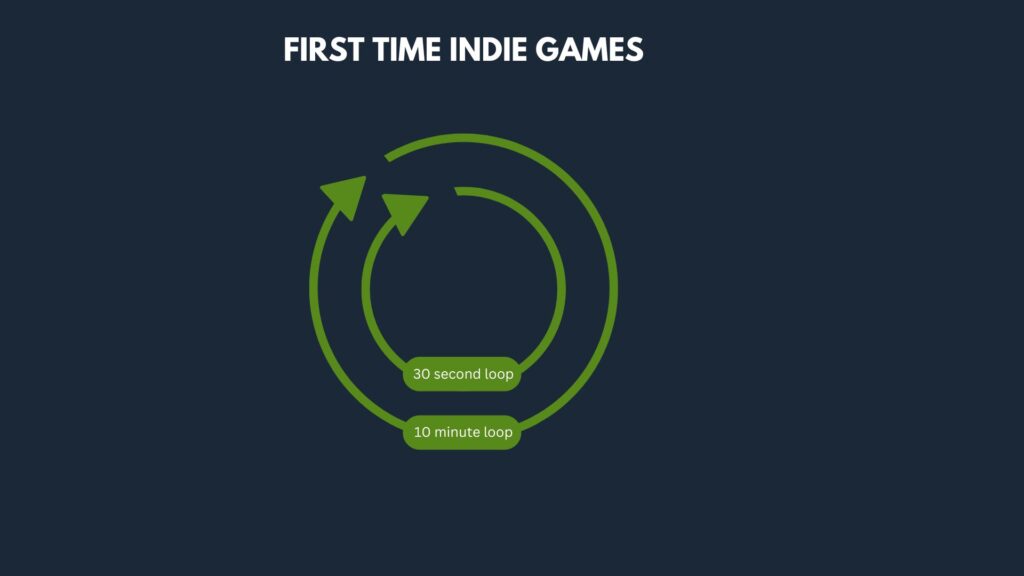
I have noticed that a lot of first time developers start out by making quick, simple “arcade” games like a new take on Asteroids or Lunar Lander. I think it is good for developers to do so they can learn game development, but these games rarely do well on Steam because they have no outer loop. Typically these games have a “high score” or “best times speed run” list but very few players chase that. So to most players, there is no outer loop.
Steam players LOVE metagame. This is why roguelikes are so popular. They love to play the inner and middle loop and then spend whatever resource they earn there to advance in an outer loop. The satisfaction of getting a new high score is not enough. This was a revelation I had when I first wrote about Vampire Survivors and what I called “Hyper Hardcore”
So if your outer loop is missing or very minimalistic, invest more time making this outer loop deep deep deep.
The other mistake that first time indies make is their game is too difficult. We track median playtimes over at howtomarketagame.com/benchmarks. One of the first bits of advice when you see low median playtime is to make your game easier.
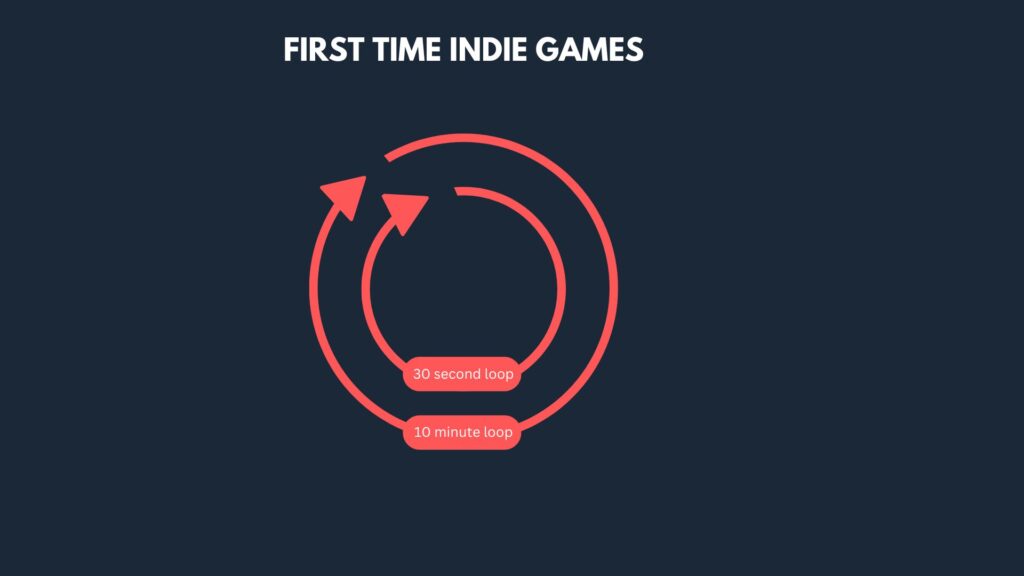
Exceptions
This blog post is very hand-wavy. I know. But there are lots of games that don’t really have loops or they are all over the place.
Horror games are different. They are basically puzzle games with blood. But I think they can be easier than most other games because people are there for the spooky vibes, not the challenging puzzles.
Narrative games also are more focused around the story and the vibes. So Visual Novels don’t always have puzzles. In fact they are enjoyed best by players when they have a lot of “choices” that players can pick from to suit their narrative.
Dark Souls are difficult at the 10 second, and 10 minute loop. But I argue that outside of games made by From Software the soulslike genre is very hard to break into.
Summary
This is not a comprehensive list. There are lots of other genres with a different mix of hard and easy sections. And I know this blog is going to generate a bunch of “but what about…”
But in general, I think the default assumption is that players want nice easy gameplay they can just pick up and then struggle through a very difficult gameplay loop. While that middle gameplay loop might be oppressive early on, buying upgrades allows players to slowly become better (or have more tools) to be able to survive longer.
Now, enough game design discussion, let me crawl back into my marketing cave.